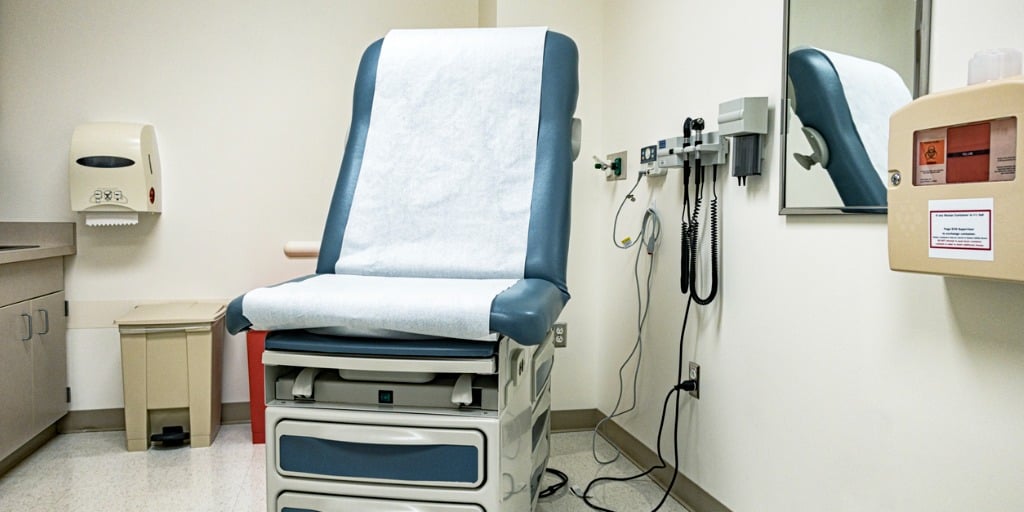Creating a medical exam room that blends patient comfort with operational efficiency is both an art and a science. A well-designed exam room not only facilitates positive patient experience but also helps clinicians and staff deliver high-quality care. In today's healthcare environment, where patient satisfaction, safety, and streamlined workflows are top of mind, properly equipping and designing an exam room is essential to the overall effectiveness of care.
In this post we will:
- Identify the healthcare equipment commonly found in primary care exam rooms by dividing the room into three theoretical zones.
- Answer the question of why the design and layout of primary care exam rooms is important.
To set the stage for this post our theoretical ‘zones’ are defined in this way:
- Patient Zone: where the patient is typically seated and examined
- Provider Zone: the space where the provider moves and interacts with the patient.
- Storage Zone: this area features casework for storage.
Identifying Healthcare Equipment in Medical Exam Rooms
The Patient Zone
The patient zone within a primary care medical exam room is where procedures, examinations, and conversations with the patient take place. Almost universally, the patient zone features a centrally positioned procedure chair or exam table that allows access to the patient from all sides. Typically, this piece of healthcare equipment is positioned so the patient can see the door but is not facing it directly.
With patient comfort and safety top of mind, there are a range of exam tables and procedure chairs available for primary care facilities. However, most will feature:
- High-low features for ADA compliance
- Adjustable backrests
- Armrests
- Bariatric capacity up to 700 pounds.
- Smart features such as safety switches and power controls
![]() Learn more: Medical Exam Table and Procedure Chair Buying Guide
Learn more: Medical Exam Table and Procedure Chair Buying Guide
The Provider Zone
The provider zone typically surrounds the patient zone and includes devices, tools, and equipment required to conduct an exam or perform a procedure, as well as document essential patient information.
Here is a breakdown of healthcare equipment typically found in this area
- Computer and Electronic Health Record (EHR) System: This is the cornerstone of the provider zone. It allows the provider to access patient histories, document findings, order tests and medications, and communicate with other healthcare professionals. Workstations on Wheels consisting of a computer, monitor, keyboard, and mouse have become the go to equipment for record keeping.
- Diagnostic Wall Systems/Vital signs Devices
- Stethoscope
- Otoscope
- Ophthalmoscope
- Blood pressure devices
- Thermometer
- Pulse Oximeter
![]() Learn more: Diagnostic Wall System Buying Guide
Learn more: Diagnostic Wall System Buying Guide
- Other Essential Examination Tools:
- Exam Light
- Weight Scale and Measuring Tape
- Penlight
- Tuning Forks
- Reflex Hammer
- Physician’s Exam Stool
- Patient Chair(s)
The Supply Zone
The supply zone, often located near the entrance of the exam room or within arm’s reach of the clinical zone, ensures healthcare providers can quickly retrieve necessary consumable supplies without disrupting patient care.
Common Healthcare Equipment in the Supply Zone:
- Storage Casework: Essential for organizing and storing a wide variety of medical supplies, these units may be wall-mounted or freestanding and feature shelves, drawers, and a small sink. Some may have locking mechanisms for securing controlled substances or sensitive materials.
 Learn more: The 9 Best Materials for Healthcare Facility Casework
Learn more: The 9 Best Materials for Healthcare Facility Casework - Countertops or Work Surfaces: These workspaces serve multiple functions, including preparation of treatments or point-of-care tests, organizing medications, and storing sanitizer dispensers or sharps containers. Frequently these surfaces are integrated into casework.
- Medical Cart: These carts serve a variety of purposes, from shelved general utility carts used for transporting supplies or equipment between exam rooms to dedicated procedure, medication, or crash carts stocked with specific supplies and devices.
 Learn more: Medical Equipment Cart Buying Guide
Learn more: Medical Equipment Cart Buying Guide - Linen Hamper: A container, usually with a lid and often foot-operated, for collecting soiled linens such as gowns and drapes.
It is important to remember that the exact layout and specific equipment found in medical exam rooms can vary depending on the focus of the primary care practice, the provider's preferences, and the available space. The healthcare equipment included in this discussion is representative of equipment commonly used for physical examinations.
Why the Design and Layout of Primary Care Exam Rooms is Important
Design and layout play a role in shaping the patient experience and optimizing the functionality of primary care rooms. From patient comfort to improving the workflow efficiency of healthcare providers, every aspect of the room's design impacts the quality of care delivered. Here’s how:
Patient Safety:
- Clear Pathways: A well-organized layout minimizes tripping hazards and facilitates unobstructed movement of both patients and healthcare providers.
- Accessibility: Proper spacing and the right healthcare equipment (like adjustable exam tables) ensure that patients with mobility issues, those using wheelchairs or needing assistance, can safely access the exam space and equipment.
- Infection Control: The placement of sinks, hand sanitizer dispensers, and waste receptacles (including sharps containers) is crucial for maintaining hygiene and preventing the spread of infections. Easy access to these items encourages their use.
- Emergency Access: In the event of a medical emergency, a clear and functional layout allows for quick access to emergency equipment and the efficient movement of personnel.
Healthcare Provider Efficiency and Ergonomics:
- Workflow Optimization: A thoughtfully designed room reduces unnecessary movement and gives providers access to equipment and supplies quickly and easily.
- Ergonomics: The placement and type of furniture (like adjustable stools and exam tables) can significantly impact the provider's comfort and reduce the risk of musculoskeletal injuries from awkward postures or repetitive movements. Easy access to the EHR system and instruments is also essential.
- Improved Communication: A layout that facilitates eye contact and comfortable interaction between the provider and patient can improve communication and build trust.
Patient Comfort and Experience:
- Reduced Anxiety: A clean, organized, and comfortable environment can help to reduce the anxiety often associated with medical visits.
- Privacy and Dignity: Central placement of the exam table helps ensure patient privacy during examinations and discussions.
- Accessibility: As mentioned earlier, easy access to the exam table and movement within the room contributes to a more positive experience for patients with mobility challenges.
- Improved Communication: When the provider can interact with the patient comfortably, at eye level, open communication follows.
Efficient Use of Space:
- Maximizing Functionality: A well-planned layout ensures that even smaller exam rooms can accommodate all necessary casework and equipment without feeling cramped or cluttered.
In summary, the layout of casework and healthcare equipment in exam rooms is not just about aesthetics; it is a foundation for delivering safe, efficient, and patient-centered care. A well-designed space supports the science of workflow and the art of patient comfort.
Partner with CME Corp. to Design and Equip Primary Care Exam Rooms
As the United States’ largest specialty distributor solely focused on equipment used in healthcare, we have built long term relationships with industry leading manufacturers and can help equip primary care exam rooms from the casework to the lighting and all the medical equipment in between.
Our expert account managers will work with you and the manufacturers’ representatives to layout and equip exam rooms with devices and furniture tailored to the needs of the patient population, staff, available space, and budget.
Complementing CME’s expert focus on equipment used in healthcare are design and layout, project management, direct-to-site delivery, and biomedical services. We are the only medical equipment distributor nationwide, able to say we are truly a one-stop shop.
Direct-To-Site Logistics and Delivery Services
In addition to delivering medical equipment fully assembled, right to the exam room, when it is convenient for staff, our in-house Direct-to-Site services teams will install equipment, like wall-mounted diagnostic systems, they are ready for immediate use.
Biomedical Services
Our in-house Biomedical Equipment Technicians (BMETs) can support facility biomed teams by performing scheduled annual preventive maintenance on critical equipment such as vital signs monitors as well as perform check-in assessments on new devices.
Find your account manager and learn how CME can help you equip your facility with the mobile healthcare equipment you need and keep you in budget.
About CME: CME Corp is the nation’s premier source for healthcare equipment, turnkey logistics, and biomedical services, representing 2 million+ products from more than 2,000 manufacturers. With 24 locations strategically positioned across the country and increasing, we are readily accessible to our customers. Our mission is to help healthcare facilities nationwide reduce the cost of the equipment they purchase, make their equipment specification, delivery, installation, and maintenance processes more efficient, and help them seamlessly launch, renovate and expand on schedule.



